 | Thunder Bay Press
An imprint of Printers Row Publishing Group
10350 Barnes Canyon Road, Suite 100, San Diego, CA 92121
www.thunderbaybooks.com |
Copyright 2018 Thunder Bay Press All rights reserved. No part of this publication may be reproduced, distributed, or transmitted in any form or by any means, including photocopying, recording, or other electronic or mechanical methods, without the prior written permission of the publisher, except in the case of brief quotations embodied in critical reviews and certain other noncommercial uses permitted by copyright law. Printers Row Publishing Group is a division of Readerlink Distribution Services, LLC.
Thunder Bay Press is a registered trademark of Readerlink Distribution Services, LLC. Correspondence concerning the content of this book and kit should be addressed to Thunder Bay Press, Editorial Department, at the above address. Author inquiries should be addressed to The Book Shop, Ltd., 7 Peter Cooper Road, #7G, New York, NY 10010.
Thunder Bay Press Publisher: Peter Norton
Associate Publisher: Ana Parker
Publishing/Editorial Team: April Farr, Vicki Jaeger, Kelly Larsen, Stephanie Romero,
Kathryn C.
Dalby, Carrie Davis
Editorial Team: JoAnn Padgett, Melinda Allman
Production Team: Jonathan Lopes, Rusty von Dyl Developed by The Book Shop, Ltd., www.thebookshopltd.com
Project designs by Janine Holmes
Illustrations by Meryl Henderson (pages 815, 17, 19, 20 top, 21 top, 23 left column)
and Chellie Carroll (pages 16, 20 bottom, 21 bottom, 22, 23 top)
Package and book design by Kimberly Shake
Edited by Masao Donahue
Photography by Carlos Chiossone eBook ISBN: 978-1-68412-806-8
eBook Edition: May 2019
contents

To make the patterns in this book, youll probably want to stock up on supplies! Yarn When it comes to yarn for your toy projects, think quality over quantity. Look for high-quality yarns that will crochet into a smooth and sturdy material. Easy-to-clean and/or washing-machine-safe cottons, blended fibers, and acrylic yarns are ideal for making toys. Stuffing Available in most craft stores, polyester fiberfill stuffing will maintain its loft over time and is easy to clean and care for. Hooks Crochet hooks come in a variety of materials, sizes, and handle styles. Its ideal if you can try a hook or two out before purchasing a set.
For the most accurate sizing, refer to the millimeter measurements when selecting a hook for your project. Scissors A good pair of scissors will make for clean cuts and quick snips. Tapestry Needle A quality metal tapestry needle will make sewing your work together a snap! Avoid plastic needles as they sometimes bend when going through multiple layers of crochet. 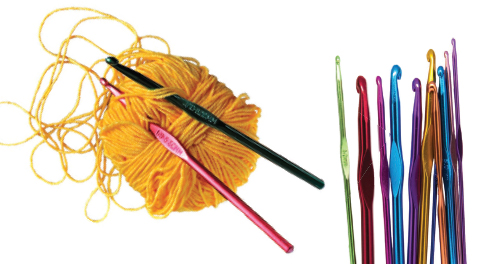 Textured Yarn There are two types of textured yarn used for the animals in this book. One is referred to as fleecy yarn (also known as chenille yarn) and the other is referred to as furry yarn (also known as eyelash or filament yarn).
Textured Yarn There are two types of textured yarn used for the animals in this book. One is referred to as fleecy yarn (also known as chenille yarn) and the other is referred to as furry yarn (also known as eyelash or filament yarn).  Safety Eyes Safety eyes are attached using a plastic washer and are great for toys intended for children ages three and older.
Safety Eyes Safety eyes are attached using a plastic washer and are great for toys intended for children ages three and older.
For children younger than three years of age, eyes can be embroidered on in tight groupings of satin stitches. Notions and Storage Here is a list of a few more goodies to add to your crochet supplies! Stitch Counter: A row or stitch counter will help you keep track of where you are in your pattern. Marking Pins: Super handy for helping to position your pattern pieces before sewing everything together. Split or Locking Rings: While some patterns will specifically call for place markers (abbreviation: pm) to help mark useful landmarks on your work, these rings can also help you track where your rounds begin, mark the corners of a square piece, or hold two edges of your work together for easier sewing. Automatic Pencil and Sticky Notes: Great for jotting down notes and sticking them into your book as you work. 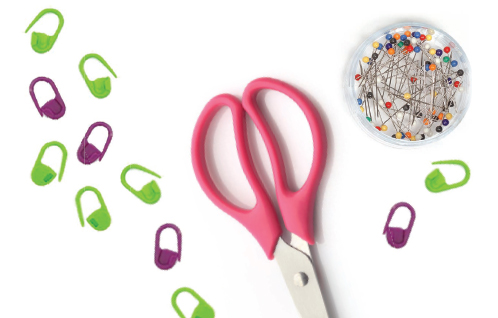 Ball-Tip Bristle Brush: Very useful for teasing out the filaments of the furry yarn once you have finished the crocheted pieces.
Ball-Tip Bristle Brush: Very useful for teasing out the filaments of the furry yarn once you have finished the crocheted pieces.
By doing this you will end up with a much fluffier fabric. Suede Brush: A suede brush can be used to brush out yarn to make it fluffier. Tweezers: A handy tool for stuffing small or narrow pieces of crochet. Tweezers also make topping up with stuffing just before you close a finishing hole or seam much easier. Project Bags: A small project bag (like a pencil case) is great for storing smaller tools and notions while a larger bag can hold everything you need for your current project. I find that reusable canvas shopping bags make great project bags! 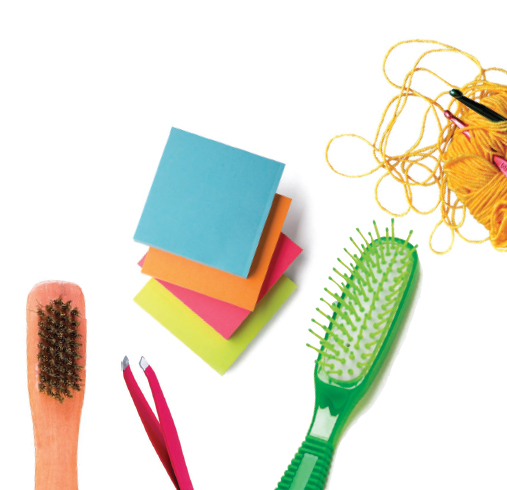
THIS SECTION WILL PROVIDE A complete overview of the stitches used in all ten projects.
Where relevant, abbreviations used in the crochet instructions can be found here. For a complete list, see . Slipknot Make a loop with a 6" tail. Overlap the loop on top of the yarn coming out of the skein.  1. SLIPKNOT Insert your hook into the loop and under the yarn.
1. SLIPKNOT Insert your hook into the loop and under the yarn.
Pull to tighten the loop around the hook.  2. SLIPKNOT Yarn Over (YO) Wrap the yarn over your hook from back to front.
2. SLIPKNOT Yarn Over (YO) Wrap the yarn over your hook from back to front. 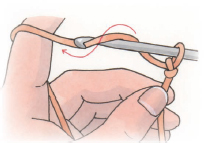 YARN OVER Chain (ch) Make a slipknot on your hook. Yarn over (YO) and draw the yarn through the loop on your hook.
YARN OVER Chain (ch) Make a slipknot on your hook. Yarn over (YO) and draw the yarn through the loop on your hook. 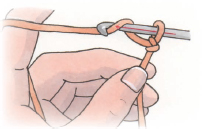 1 & 2.
1 & 2.  1 & 2.
1 & 2.
CHAIN Repeat step 2 until you have made the number of chain stitches specified in the pattern. When counting chains, only count the chains below the loop on the hook. 



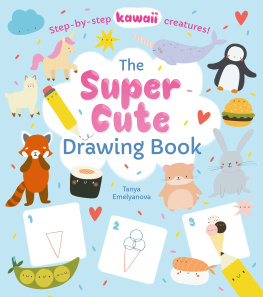
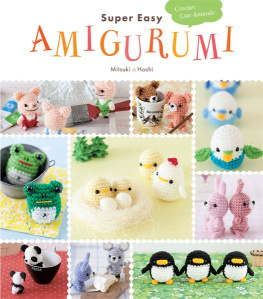

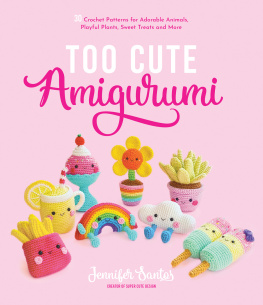
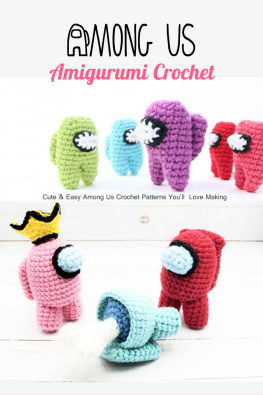
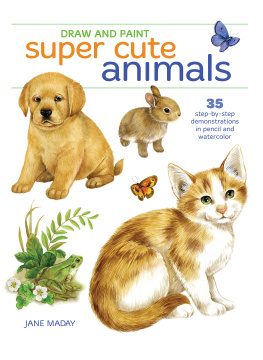

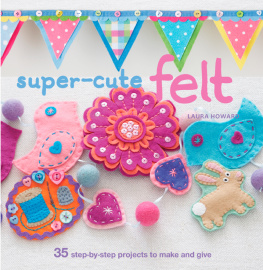
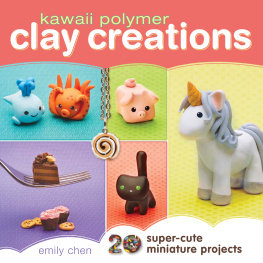

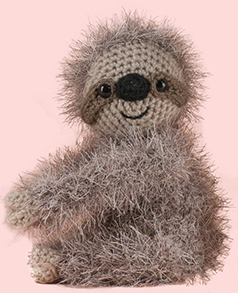



 Textured Yarn There are two types of textured yarn used for the animals in this book. One is referred to as fleecy yarn (also known as chenille yarn) and the other is referred to as furry yarn (also known as eyelash or filament yarn).
Textured Yarn There are two types of textured yarn used for the animals in this book. One is referred to as fleecy yarn (also known as chenille yarn) and the other is referred to as furry yarn (also known as eyelash or filament yarn).  Safety Eyes Safety eyes are attached using a plastic washer and are great for toys intended for children ages three and older.
Safety Eyes Safety eyes are attached using a plastic washer and are great for toys intended for children ages three and older. Ball-Tip Bristle Brush: Very useful for teasing out the filaments of the furry yarn once you have finished the crocheted pieces.
Ball-Tip Bristle Brush: Very useful for teasing out the filaments of the furry yarn once you have finished the crocheted pieces.
 1. SLIPKNOT Insert your hook into the loop and under the yarn.
1. SLIPKNOT Insert your hook into the loop and under the yarn. 2. SLIPKNOT Yarn Over (YO) Wrap the yarn over your hook from back to front.
2. SLIPKNOT Yarn Over (YO) Wrap the yarn over your hook from back to front.  YARN OVER Chain (ch) Make a slipknot on your hook. Yarn over (YO) and draw the yarn through the loop on your hook.
YARN OVER Chain (ch) Make a slipknot on your hook. Yarn over (YO) and draw the yarn through the loop on your hook.  1 & 2.
1 & 2. 